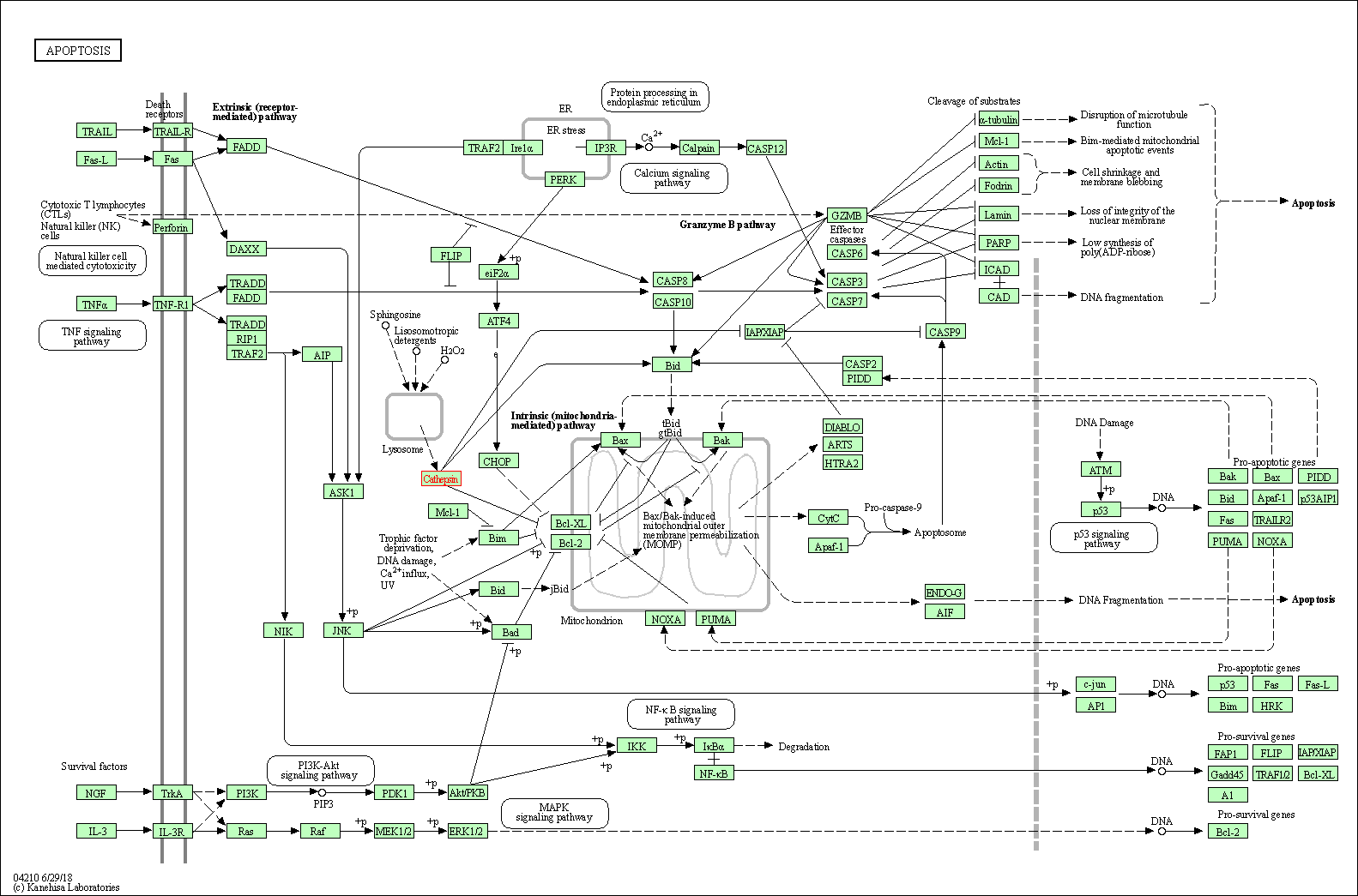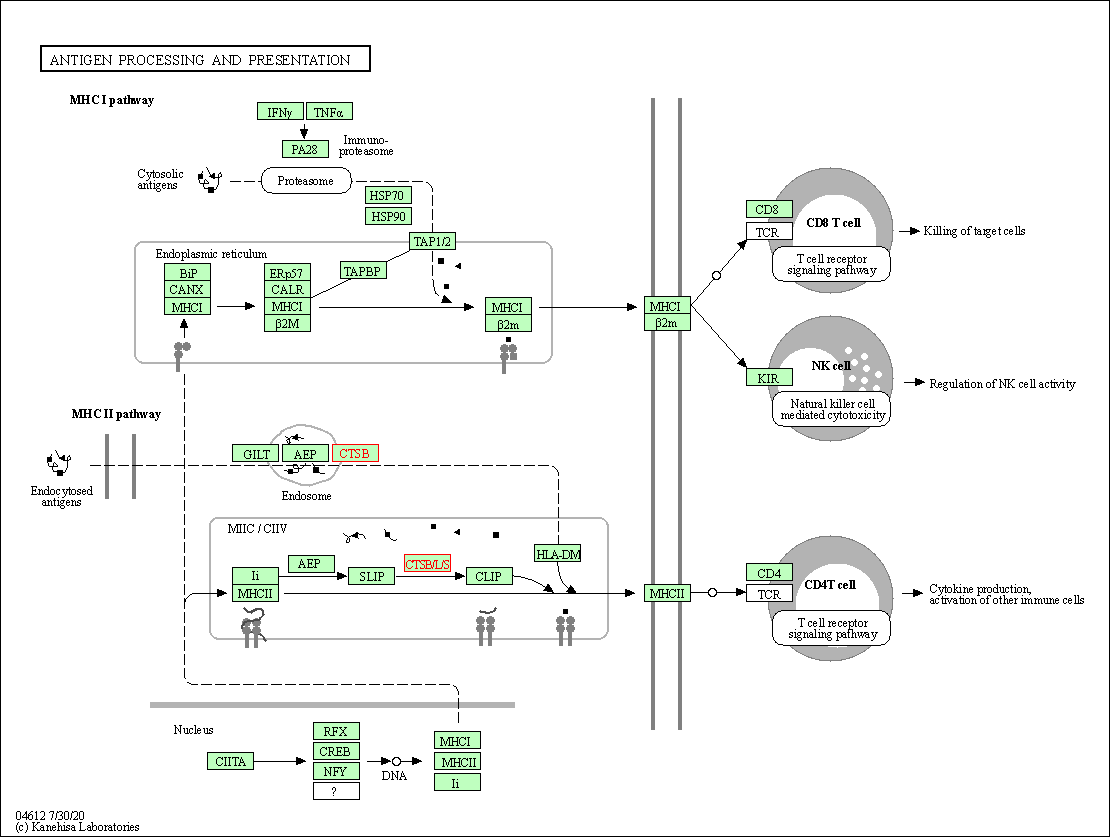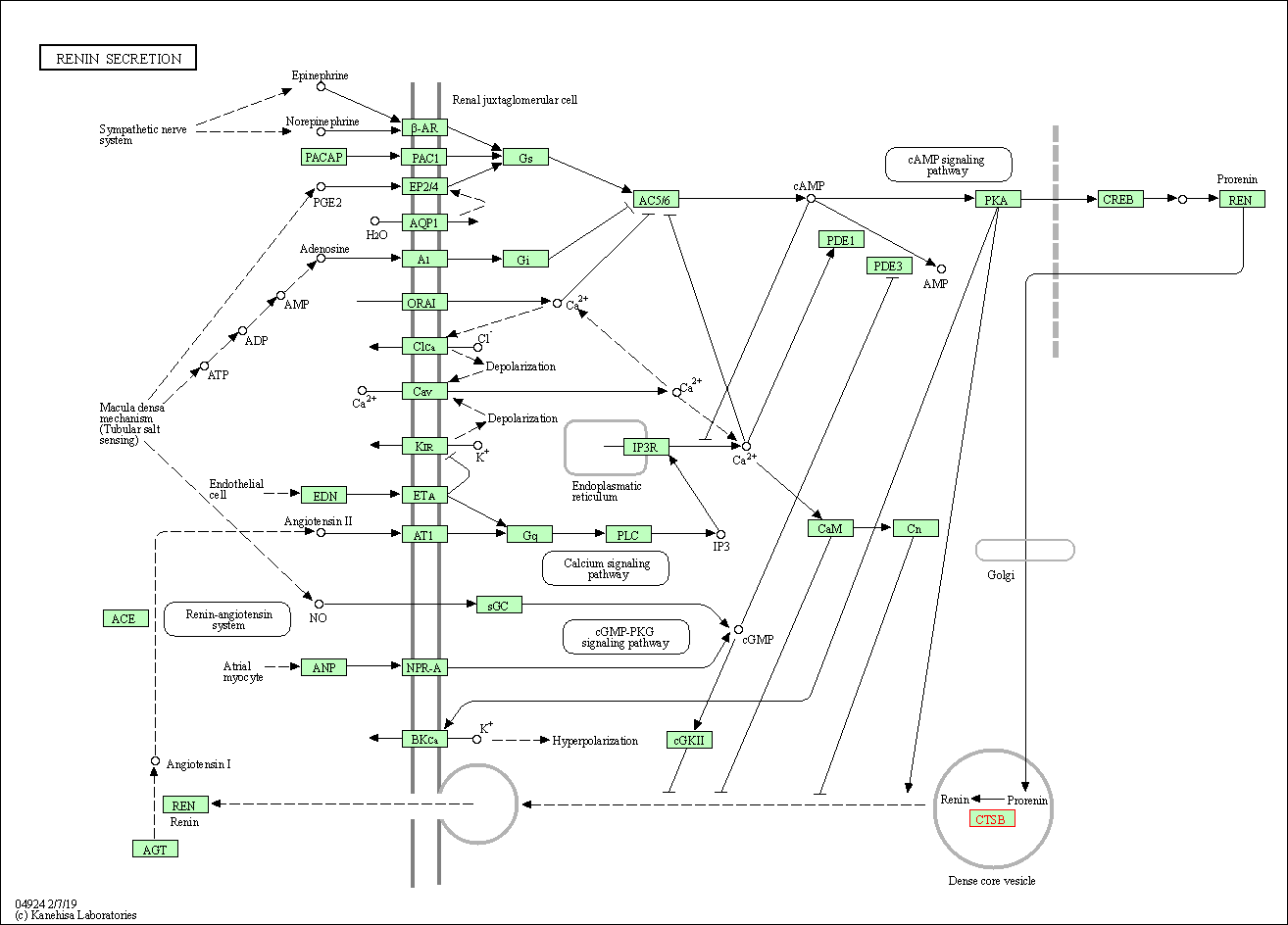Target Information
| Target General Information | Top | |||||
|---|---|---|---|---|---|---|
| Target ID |
T61746
(Former ID: TTDR00886)
|
|||||
| Target Name |
Cathepsin B (CTSB)
|
|||||
| Synonyms |
Ctsb; Cathepsins B; Cathepsin-B; Cathepsin B1; CPSB; APPS; APP secretase
Click to Show/Hide
|
|||||
| Gene Name |
CTSB
|
|||||
| Target Type |
Preclinical target
|
[1] | ||||
| Disease | [+] 21 Target-related Diseases | + | ||||
| 1 | Alopecia [ICD-11: ED70] | |||||
| 2 | Bone cancer [ICD-11: 2B5Z] | |||||
| 3 | Brain cancer [ICD-11: 2A00] | |||||
| 4 | Cerebral ischaemic stroke [ICD-11: 8B11] | |||||
| 5 | Chronic obstructive pulmonary disease [ICD-11: CA22] | |||||
| 6 | Chronic pain [ICD-11: MG30] | |||||
| 7 | Digestive system disease [ICD-11: DE2Z] | |||||
| 8 | Hepatic fibrosis/cirrhosis [ICD-11: DB93] | |||||
| 9 | Meningioma [ICD-11: 2A01] | |||||
| 10 | Metastatic tumour [ICD-11: 2D50-2E2Z] | |||||
| 11 | Multiple sclerosis [ICD-11: 8A40] | |||||
| 12 | Neurodegenerative disorder [ICD-11: 8A20-8A23] | |||||
| 13 | Pancreatitis [ICD-11: DC31-DC34] | |||||
| 14 | Psoriasis [ICD-11: EA90] | |||||
| 15 | Rheumatoid arthritis [ICD-11: FA20] | |||||
| 16 | Alzheimer disease [ICD-11: 8A20] | |||||
| 17 | Cardiac arrest [ICD-11: MC82] | |||||
| 18 | Cystic fibrosis [ICD-11: CA25] | |||||
| 19 | Idiopathic interstitial pneumonitis [ICD-11: CB03] | |||||
| 20 | Osteoarthritis [ICD-11: FA00-FA05] | |||||
| 21 | Asthma [ICD-11: CA23] | |||||
| Function |
Cleaves matrix extracellular phosphoglycoprotein MEPE. Has also been implicated in tumor invasion and metastasis. Thiol protease which is believed to participate in intracellular degradation and turnover of proteins.
Click to Show/Hide
|
|||||
| BioChemical Class |
Peptidase
|
|||||
| UniProt ID | ||||||
| EC Number |
EC 3.4.22.1
|
|||||
| Sequence |
MWQLWASLCCLLVLANARSRPSFHPLSDELVNYVNKRNTTWQAGHNFYNVDMSYLKRLCG
TFLGGPKPPQRVMFTEDLKLPASFDAREQWPQCPTIKEIRDQGSCGSCWAFGAVEAISDR ICIHTNAHVSVEVSAEDLLTCCGSMCGDGCNGGYPAEAWNFWTRKGLVSGGLYESHVGCR PYSIPPCEHHVNGSRPPCTGEGDTPKCSKICEPGYSPTYKQDKHYGYNSYSVSNSEKDIM AEIYKNGPVEGAFSVYSDFLLYKSGVYQHVTGEMMGGHAIRILGWGVENGTPYWLVANSW NTDWGDNGFFKILRGQDHCGIESEVVAGIPRTDQYWEKI Click to Show/Hide
|
|||||
| 3D Structure | Click to Show 3D Structure of This Target | PDB | ||||
| HIT2.0 ID | T90ZKN | |||||
| Drugs and Modes of Action | Top | |||||
|---|---|---|---|---|---|---|
| Patented Agent(s) | [+] 10 Patented Agents | + | ||||
| 1 | Dimethoxybenzylidene-2-thio-imidazole-4-one derivative 1 | Drug Info | Patented | Cerebral ischemia | [1] | |
| 2 | PMID27998201-Compound-11 | Drug Info | Patented | Metastatic cancer | [1] | |
| 3 | PMID27998201-Compound-12 | Drug Info | Patented | Cancer related pain | [1] | |
| 4 | PMID27998201-Compound-13 | Drug Info | Patented | Hepatic fibrosis | [1] | |
| 5 | PMID27998201-Compound-17 | Drug Info | Patented | Hair loss | [1] | |
| 6 | PMID27998201-Compound-2 | Drug Info | Patented | Alzheimer disease | [1] | |
| 7 | PMID27998201-Compound-22 | Drug Info | Patented | Neurodegenerative disorder | [1] | |
| 8 | PMID27998201-Compound-24 | Drug Info | Patented | Meningioma tumour | [1] | |
| 9 | PMID27998201-Compound-5 | Drug Info | Patented | Cirrhosis | [1] | |
| 10 | PMID27998201-Compound-9 | Drug Info | Patented | Rheumatoid arthritis | [1] | |
| Preclinical Drug(s) | [+] 5 Preclinical Drugs | + | ||||
| 1 | CA-074Me | Drug Info | Preclinical | Cardiac arrest | [2] | |
| 2 | L-006235-1 | Drug Info | Preclinical | Osteoarthritis | [3] | |
| 3 | SD1002 | Drug Info | Preclinical | Alzheimer disease | [4] | |
| 4 | SD1003 | Drug Info | Preclinical | Alzheimer disease | [4] | |
| 5 | Z-Phe-Ala-diazomethylketone | Drug Info | Preclinical | Alzheimer disease | [4] | |
| Mode of Action | [+] 1 Modes of Action | + | ||||
| Inhibitor | [+] 45 Inhibitor drugs | + | ||||
| 1 | Dimethoxybenzylidene-2-thio-imidazole-4-one derivative 1 | Drug Info | [1] | |||
| 2 | PMID27998201-Compound-11 | Drug Info | [1] | |||
| 3 | PMID27998201-Compound-12 | Drug Info | [1] | |||
| 4 | PMID27998201-Compound-13 | Drug Info | [1] | |||
| 5 | PMID27998201-Compound-17 | Drug Info | [1] | |||
| 6 | PMID27998201-Compound-2 | Drug Info | [1] | |||
| 7 | PMID27998201-Compound-22 | Drug Info | [1] | |||
| 8 | PMID27998201-Compound-24 | Drug Info | [1] | |||
| 9 | PMID27998201-Compound-5 | Drug Info | [1] | |||
| 10 | PMID27998201-Compound-9 | Drug Info | [1] | |||
| 11 | CA-074Me | Drug Info | [5] | |||
| 12 | L-006235-1 | Drug Info | [6] | |||
| 13 | SD1002 | Drug Info | [4] | |||
| 14 | SD1003 | Drug Info | [4] | |||
| 15 | Z-Phe-Ala-diazomethylketone | Drug Info | [4] | |||
| 16 | (S)-1-benzylcyclopentyl 1-oxohexan-2-ylcarbamate | Drug Info | [7] | |||
| 17 | 1-(phenyl(p-tolyl)methylene)thiosemicarbazide | Drug Info | [8] | |||
| 18 | 2-Aminoethanimidic Acid | Drug Info | [9] | |||
| 19 | 2-Pyridinethiol | Drug Info | [10] | |||
| 20 | 3-Amino-4-Oxybenzyl-2-Butanone | Drug Info | [9] | |||
| 21 | 3-Methylphenylalanine | Drug Info | [9] | |||
| 22 | Ac-hPhe-Leu-Ala-LeuVSMe | Drug Info | [11] | |||
| 23 | Ac-hPhe-Leu-Phe-LeuVSMe | Drug Info | [11] | |||
| 24 | Bis(3-bromophenyl)(4-hydroxy)thiosemicarbazone | Drug Info | [12] | |||
| 25 | Cbz-Ile-Leu-Ala-LeuVSMe | Drug Info | [11] | |||
| 26 | Cbz-Ile-t-ButylhomoGlu-Ala-LeuVSMe | Drug Info | [11] | |||
| 27 | Diphenylacetic Acid | Drug Info | [9] | |||
| 28 | GNF-PF-5434 | Drug Info | [13] | |||
| 29 | Gold trichloride sodium chloride | Drug Info | [14] | |||
| 30 | L-873724 | Drug Info | [15] | |||
| 31 | PTosyl-Glu(OtBu)-Ala-LeuVSMe | Drug Info | [11] | |||
| 32 | Z-Ala-Leu-His-Agly-Ile-Val-OMe | Drug Info | [16] | |||
| 33 | Z-Ala-Leu-lle-Agly-Ile-Val-NHBzl | Drug Info | [16] | |||
| 34 | Z-Ala-Leu-lle-Agly-Ile-Val-OMe | Drug Info | [16] | |||
| 35 | Z-Ala-Leu-Nal-Agly-Ile-Val-OMe | Drug Info | [16] | |||
| 36 | Z-Ala-Leu-Phe-Agly-Ile-Val-OMe | Drug Info | [16] | |||
| 37 | Z-Ala-Leu-Tyr(Me)-Agly-Ile-Val-OMe | Drug Info | [16] | |||
| 38 | Z-Arg-Leu-Val-Agly-Ala-Gly-NH2 | Drug Info | [16] | |||
| 39 | Z-Arg-Leu-Val-Agly-Ile-Val-OMe | Drug Info | [16] | |||
| 40 | Z-Arg-Leu-Val-Agly-Ile-Val-Trp-NH2 | Drug Info | [16] | |||
| 41 | Z-Arg-Leu-Val-Agly-Ileu-Val-OMe | Drug Info | [16] | |||
| 42 | Z-Arg-Leu-Val-Agly-Trp-Val-Ala-NH2 | Drug Info | [16] | |||
| 43 | Z-Arg-Leu-Val-Agly-Val-Ala-NH2 | Drug Info | [16] | |||
| 44 | Z-leu-Val-Agly-Val-OBzl | Drug Info | [16] | |||
| 45 | [(3-Bromophenyl)-p-tolyl-ketone]thiosemicarbazone | Drug Info | [17] | |||
| Cell-based Target Expression Variations | Top | |||||
|---|---|---|---|---|---|---|
| Cell-based Target Expression Variations | ||||||
| Drug Binding Sites of Target | Top | |||||
|---|---|---|---|---|---|---|
| Ligand Name: 2-Aminoethanimidic Acid | Ligand Info | |||||
| Structure Description | Cathepsin B complexed with dipeptidyl nitrile inhibitor | PDB:1GMY | ||||
| Method | X-ray diffraction | Resolution | 1.90 Å | Mutation | No | [18] |
| PDB Sequence |
KLPASFDARE
9 QWPQCPTIKE19 IRDQGSCGSC29 WAFGAVEAIS39 DRICIHTNAH49 VSVEVSAEDL 59 LTCCGSMCGD69 GCNGGYPAEA79 WNFWTRKGLV89 SGGLYESHVG99 CRPYSIPPCE 109 HHVNGSRPPC119 TGEGDTPKCS129 KICEPGYSPT139 YKQDKHYGYN149 SYSVSNSEKD 159 IMAEIYKNGP169 VEGAFSVYSD179 FLLYKSGVYQ189 HVTGEMMGGH199 AIRILGWGVE 209 NGTPYWLVAN219 SWNTDWGDNG229 FFKILRGQDH239 CGIESEVVAG249 IPRT |
|||||
|
|
||||||
| Ligand Name: 3-Methylphenylalanine | Ligand Info | |||||
| Structure Description | Cathepsin B complexed with dipeptidyl nitrile inhibitor | PDB:1GMY | ||||
| Method | X-ray diffraction | Resolution | 1.90 Å | Mutation | No | [18] |
| PDB Sequence |
KLPASFDARE
9 QWPQCPTIKE19 IRDQGSCGSC29 WAFGAVEAIS39 DRICIHTNAH49 VSVEVSAEDL 59 LTCCGSMCGD69 GCNGGYPAEA79 WNFWTRKGLV89 SGGLYESHVG99 CRPYSIPPCE 109 HHVNGSRPPC119 TGEGDTPKCS129 KICEPGYSPT139 YKQDKHYGYN149 SYSVSNSEKD 159 IMAEIYKNGP169 VEGAFSVYSD179 FLLYKSGVYQ189 HVTGEMMGGH199 AIRILGWGVE 209 NGTPYWLVAN219 SWNTDWGDNG229 FFKILRGQDH239 CGIESEVVAG249 IPRT |
|||||
|
|
||||||
| Click to View More Binding Site Information of This Target with Different Ligands | ||||||
| Different Human System Profiles of Target | Top |
|---|---|
|
Human Similarity Proteins
of target is determined by comparing the sequence similarity of all human proteins with the target based on BLAST. The similarity proteins for a target are defined as the proteins with E-value < 0.005 and outside the protein families of the target.
A target that has fewer human similarity proteins outside its family is commonly regarded to possess a greater capacity to avoid undesired interactions and thus increase the possibility of finding successful drugs
(Brief Bioinform, 21: 649-662, 2020).
Human Tissue Distribution
of target is determined from a proteomics study that quantified more than 12,000 genes across 32 normal human tissues. Tissue Specificity (TS) score was used to define the enrichment of target across tissues.
The distribution of targets among different tissues or organs need to be taken into consideration when assessing the target druggability, as it is generally accepted that the wider the target distribution, the greater the concern over potential adverse effects
(Nat Rev Drug Discov, 20: 64-81, 2021).
Human Pathway Affiliation
of target is determined by the life-essential pathways provided on KEGG database. The target-affiliated pathways were defined based on the following two criteria (a) the pathways of the studied target should be life-essential for both healthy individuals and patients, and (b) the studied target should occupy an upstream position in the pathways and therefore had the ability to regulate biological function.
Targets involved in a fewer pathways have greater likelihood to be successfully developed, while those associated with more human pathways increase the chance of undesirable interferences with other human processes
(Pharmacol Rev, 58: 259-279, 2006).
Biological Network Descriptors
of target is determined based on a human protein-protein interactions (PPI) network consisting of 9,309 proteins and 52,713 PPIs, which were with a high confidence score of ≥ 0.95 collected from STRING database.
The network properties of targets based on protein-protein interactions (PPIs) have been widely adopted for the assessment of target’s druggability. Proteins with high node degree tend to have a high impact on network function through multiple interactions, while proteins with high betweenness centrality are regarded to be central for communication in interaction networks and regulate the flow of signaling information
(Front Pharmacol, 9, 1245, 2018;
Curr Opin Struct Biol. 44:134-142, 2017).
Human Similarity Proteins
Human Tissue Distribution
Human Pathway Affiliation
Biological Network Descriptors
|
|
|
There is no similarity protein (E value < 0.005) for this target
|
|
Note:
If a protein has TS (tissue specficity) scores at least in one tissue >= 2.5, this protein is called tissue-enriched (including tissue-enriched-but-not-specific and tissue-specific). In the plots, the vertical lines are at thresholds 2.5 and 4.
|






| KEGG Pathway | Pathway ID | Affiliated Target | Pathway Map |
|---|---|---|---|
| Autophagy - animal | hsa04140 | Affiliated Target |

|
| Class: Cellular Processes => Transport and catabolism | Pathway Hierarchy | ||
| Lysosome | hsa04142 | Affiliated Target |

|
| Class: Cellular Processes => Transport and catabolism | Pathway Hierarchy | ||
| Apoptosis | hsa04210 | Affiliated Target |

|
| Class: Cellular Processes => Cell growth and death | Pathway Hierarchy | ||
| Antigen processing and presentation | hsa04612 | Affiliated Target |

|
| Class: Organismal Systems => Immune system | Pathway Hierarchy | ||
| NOD-like receptor signaling pathway | hsa04621 | Affiliated Target |

|
| Class: Organismal Systems => Immune system | Pathway Hierarchy | ||
| Renin secretion | hsa04924 | Affiliated Target |

|
| Class: Organismal Systems => Endocrine system | Pathway Hierarchy | ||
| Click to Show/Hide the Information of Affiliated Human Pathways | |||
| Degree | 6 | Degree centrality | 6.45E-04 | Betweenness centrality | 4.32E-04 |
|---|---|---|---|---|---|
| Closeness centrality | 1.98E-01 | Radiality | 1.34E+01 | Clustering coefficient | 0.00E+00 |
| Neighborhood connectivity | 7.17E+00 | Topological coefficient | 1.71E-01 | Eccentricity | 12 |
| Download | Click to Download the Full PPI Network of This Target | ||||
| Chemical Structure based Activity Landscape of Target | Top |
|---|---|
| Drug Property Profile of Target | Top | |
|---|---|---|
| (1) Molecular Weight (mw) based Drug Clustering | (2) Octanol/Water Partition Coefficient (xlogp) based Drug Clustering | |
|
|
||
| (3) Hydrogen Bond Donor Count (hbonddonor) based Drug Clustering | (4) Hydrogen Bond Acceptor Count (hbondacc) based Drug Clustering | |
|
|
||
| (5) Rotatable Bond Count (rotbonds) based Drug Clustering | (6) Topological Polar Surface Area (polararea) based Drug Clustering | |
|
|
||
| "RO5" indicates the cutoff set by lipinski's rule of five; "D123AB" colored in GREEN denotes the no violation of any cutoff in lipinski's rule of five; "D123AB" colored in PURPLE refers to the violation of only one cutoff in lipinski's rule of five; "D123AB" colored in BLACK represents the violation of more than one cutoffs in lipinski's rule of five | ||
| Target Poor or Non Binders | Top | |||||
|---|---|---|---|---|---|---|
| Target Poor or Non Binders | ||||||
| Target Affiliated Biological Pathways | Top | |||||
|---|---|---|---|---|---|---|
| KEGG Pathway | [+] 2 KEGG Pathways | + | ||||
| 1 | Lysosome | |||||
| 2 | Antigen processing and presentation | |||||
| NetPath Pathway | [+] 2 NetPath Pathways | + | ||||
| 1 | TCR Signaling Pathway | |||||
| 2 | IL2 Signaling Pathway | |||||
| Reactome | [+] 4 Reactome Pathways | + | ||||
| 1 | Collagen degradation | |||||
| 2 | Trafficking and processing of endosomal TLR | |||||
| 3 | Assembly of collagen fibrils and other multimeric structures | |||||
| 4 | MHC class II antigen presentation | |||||
| Target-Related Models and Studies | Top | |||||
|---|---|---|---|---|---|---|
| Target Validation | ||||||
| References | Top | |||||
|---|---|---|---|---|---|---|
| REF 1 | Cathepsin B and L inhibitors: a patent review (2010 - present).Expert Opin Ther Pat. 2017 Jun;27(6):643-656. | |||||
| REF 2 | Drugs and Targets in Fibrosis. Front Pharmacol. 2017 Nov 23;8:855. | |||||
| REF 3 | Inhibition of cathepsin K reduces cartilage degeneration in the anterior cruciate ligament transection rabbit and murine models of osteoarthritis. Bone. 2012 Jun;50(6):1250-9. | |||||
| REF 4 | Lysosomes as a therapeutic target. Nat Rev Drug Discov. 2019 Dec;18(12):923-948. | |||||
| REF 5 | CA-074Me inhibits Cathepsin-B and alleviates fibrosis after myocardial infarction. Panminerva Med. 2019 Sep 24. | |||||
| REF 6 | Lysosomotropism of basic cathepsin K inhibitors contributes to increased cellular potencies against off-target cathepsins and reduced functional se... J Med Chem. 2005 Dec 1;48(24):7535-43. | |||||
| REF 7 | Semicarbazone-based inhibitors of cathepsin K, are they prodrugs for aldehyde inhibitors Bioorg Med Chem Lett. 2006 Feb 15;16(4):978-83. | |||||
| REF 8 | Discovery of trypanocidal thiosemicarbazone inhibitors of rhodesain and TbcatB. Bioorg Med Chem Lett. 2008 May 1;18(9):2883-5. | |||||
| REF 9 | How many drug targets are there Nat Rev Drug Discov. 2006 Dec;5(12):993-6. | |||||
| REF 10 | DrugBank 3.0: a comprehensive resource for 'omics' research on drugs. Nucleic Acids Res. 2011 Jan;39(Database issue):D1035-41. | |||||
| REF 11 | Optimization of subsite binding to the beta5 subunit of the human 20S proteasome using vinyl sulfones and 2-keto-1,3,4-oxadiazoles: syntheses and c... J Med Chem. 2006 May 18;49(10):2953-68. | |||||
| REF 12 | Functionalized benzophenone, thiophene, pyridine, and fluorene thiosemicarbazone derivatives as inhibitors of cathepsin L. Bioorg Med Chem Lett. 2010 Nov 15;20(22):6610-5. | |||||
| REF 13 | Substrate optimization for monitoring cathepsin C activity in live cells. Bioorg Med Chem. 2009 Feb 1;17(3):1064-70. | |||||
| REF 14 | Inhibition of lysosomal cysteine proteases by chrysotherapeutic compounds: a possible mechanism for the antiarthritic activity of Au(I). Bioorg Med Chem Lett. 2004 Oct 18;14(20):5113-6. | |||||
| REF 15 | The identification of potent, selective, and bioavailable cathepsin S inhibitors. Bioorg Med Chem Lett. 2007 Sep 1;17(17):4929-33. | |||||
| REF 16 | Azapeptides structurally based upon inhibitory sites of cystatins as potent and selective inhibitors of cysteine proteases. J Med Chem. 2002 Sep 12;45(19):4202-11. | |||||
| REF 17 | Design, synthesis, and biological evaluation of potent thiosemicarbazone based cathepsin L inhibitors. Bioorg Med Chem Lett. 2010 Feb 15;20(4):1415-9. | |||||
| REF 18 | Identification of dipeptidyl nitriles as potent and selective inhibitors of cathepsin B through structure-based drug design. J Med Chem. 2001 Dec 20;44(26):4524-34. | |||||
If You Find Any Error in Data or Bug in Web Service, Please Kindly Report It to Dr. Zhou and Dr. Zhang.

